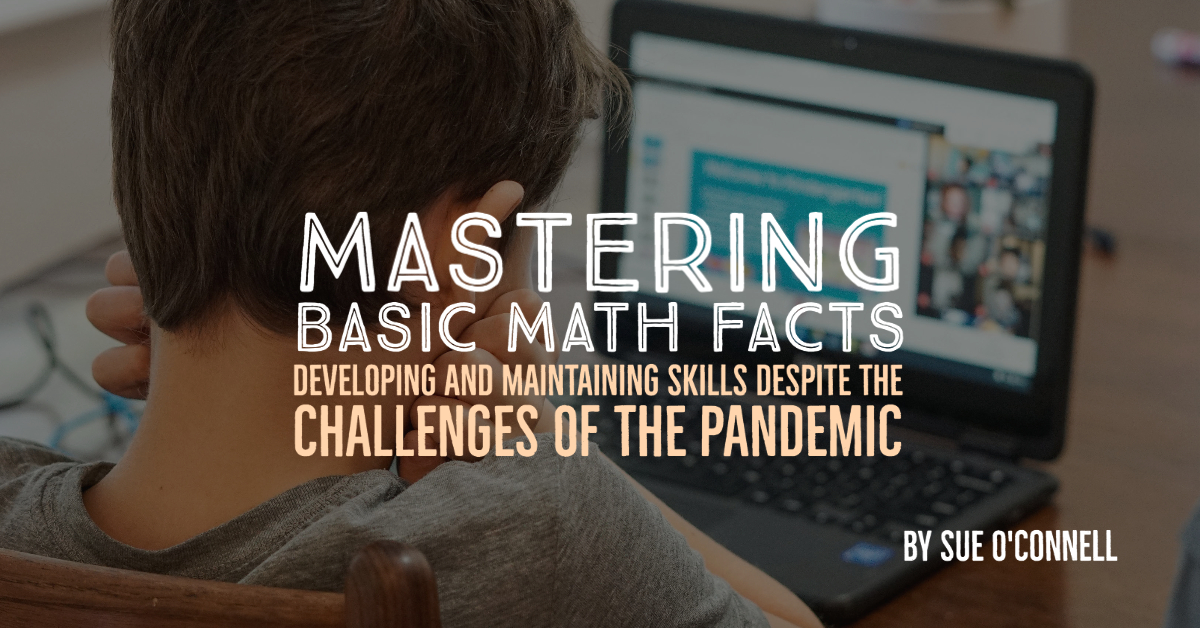
Why are math facts so important?
Knowledge of basic math facts provides a foundation for multi-digit addition, subtraction, multiplication, and division, but the importance of these facts goes far beyond the foundation for more complex computations. Through a careful study of math facts, students gain a deeper understanding of operations, greater skill at applying mental math strategies, and a stronger understanding of numbers. Their experiences with math facts shape their understanding of properties. How can 5 + 2 and 2 + 5 have the same sum (commutative property)? If you forget the product of 6 × 7, can you find it by knowing 6 × 5 and 6 × 2 (distributive property)? How do you find the quotient of 24 ÷ 4 by knowing 4 × 6 = 24 (inverse operations)? As students explore addition, subtraction, multiplication, and division math facts, they make sense of many of the core principles of mathematics and develop deep number sense.
Is fact fluency the same as memorization?
No. Memorization implies that memory alone is how an answer is gained, but with math facts, an understanding of numbers and the development of mental strategies are important factors to fluency. The student who looks at 6 + 7 and thinks “it’s one more than 6 + 6 and I know 6 + 6 = 12” arrives at the answer in a number-based way. That student’s retrieval of the fact through a mental strategy is smooth and quick (although speed is not the major concern). If a student with mental strategies forgets an answer, they are able to retrieve it through strategies, while a student who relies on memorization cannot. And a student using mental strategies is demonstrating number sense.
Why are we concerned about attention to math facts during the pandemic?
Our students benefit from lots of discussions about, and practice with, basic math facts. Daily lessons in K-5 classrooms frequently focus on the development of mental math strategies associated with different fact sets, but even when lessons focus on other math skills, fact fluency tasks appear each day at centers, in mini-lessons, or as practice tasks. With class time reduced due to online learning or briefer in-class periods, this daily exposure to math facts, and daily practice time, has been reduced or, in some cases, eliminated.
How can we focus on number patterns and mental strategies with abbreviated lesson time?
Focusing on math facts in sets that share number patterns, or common mental strategies, allows us to design brief lessons. Lessons might only last 10 minutes but can get to the critical insights that help students make sense of math fact sets. You will find lots of brief lesson ideas in the Mastering the Basic Math Facts (MTBMF) books, lessons that set the context with a story or problem, have students gather and observe some data to discover number patterns, and make connections to familiar math concepts or known facts. Following those brief teaching experiences, practice is specifically designed to focus on just that math fact set to allow students to practice applying the mental strategy they have explored. The fluency games in the MTBMF books are specific to fact sets, so rather than practice being diluted to all addition or all multiplication facts, the practice might focus on just addition doubles, ×6 facts, or whatever fact set was the focus of the lesson. This practice can be done at home. It is the selection of the practice task, to align with the facts teaching, that makes each practice session effective in moving students toward fact fluency.
How do parents know how to support their child’s fact fluency?
Most parents learned math facts through flash cards and may still believe that memorization and speed are our major goals. Without support, home practice can raise the anxiety of both students and parents and not yield the results (both number sense and fact fluency) that we desire. MTBMF provides a wealth of alternatives to flash cards and memorization tasks. The games allow parents and students to have fun together while they work toward fluency. Two parent letters appear in the online resources for each book. One letter focuses on ideas for playing fact games at home, the other shares ideas for fluency tasks with a simple set of fact cards (available in the online resources). The letters help parents better understand both our goals and appropriate at-home tasks. Both letters are customizable to allow teachers to add or delete any ideas, and both are available in English and Spanish.
What if students do not have a parent available to play the fluency games?
While most of the games were designed as partner games, many can be played alone, or be easily modified for students to play alone. Rather than competing to see who might be the first to get 4 in a row, students might just play until they get 4 in a row. Rather than competing to see who can fill a grid first, students might see if they can fill it in 12 rolls or fewer. Each online game is in Word format, so the directions are customizable. Changing a few words provides students with directions that work at home or when they are playing alone.
Would students have the materials to play the games at home?
Dice are a part of many commercial games and can be used for many of the activities, but spinner templates and fact cards are available in the online resources. Students can cut out the fact cards, which are specific to certain fact sets, and randomly pick cards to play the games. Rather than cubes or counters for game markers, students might use pennies, macaroni, or pieces of cereal as their game markers.
What specific features of the MTBMF books are most helpful?
These books take a simple approach to math fact fluency that begins with setting a context for a fact set through a piece of children’s literature, exploring the number patterns and mental strategies related to the set through models and math talk, and engaging students in fun practice to provide repeated exposure to each fact set. One book focuses on addition and subtraction facts, while the other focuses on multiplication and division facts. The following features have been built into the books and related online resources:
- lots of short, engaging lessons that focus on number patterns and mental strategies specific to each math fact set
- hundreds of online resources and game templates that are perfect tools for home practice
- online resources and games that are available in both English and Spanish, so they can be sent home with directions that are understandable to parents
- parent letters (in both English and Spanish) to help parents better understand how to support fact fluency at home
Why is it important to continue a strong focus on math facts?
We recognize that math fact understanding and fluency takes time. In most K-5 classrooms, fact fluency is a routine part of the school day. Now we face reductions in teaching time, and a reliance on at-home practice tasks, that challenge us to find ways to explore math facts with the attention they deserve. Through brief lessons that focus on critical concepts and connections, and at-home practice that is focused and meaningful, we can address math fact understanding and fluency and provide a strong foundation for our students’ math success.
 Susan O’Connell has decades of experience supporting teachers in making sense of mathematics and effectively shifting how they teach. As a former elementary teacher, reading specialist, and math coach, Sue knows what it’s like in the classroom and her background is evident throughout her work as she unpacks best practices in a clear, practical, and upbeat way.
Susan O’Connell has decades of experience supporting teachers in making sense of mathematics and effectively shifting how they teach. As a former elementary teacher, reading specialist, and math coach, Sue knows what it’s like in the classroom and her background is evident throughout her work as she unpacks best practices in a clear, practical, and upbeat way.
She is the lead author of Math in Practice, a new grade-by-grade K-5 professional learning resource. She is also coauthor of the bestselling Putting the Practices Into Action, Mastering the Basic Math Facts in Addition and Subtraction, and Mastering the Basic Math Facts in Multiplication and Division. She served as editor of Heinemann’s popular Math Process Standards series and also wrote the bestselling Now I Get It.
Sue is a nationally known speaker and education consultant who directs Quality Teacher Development, an organization committed to providing outstanding math professional development for schools and districts across the country.




